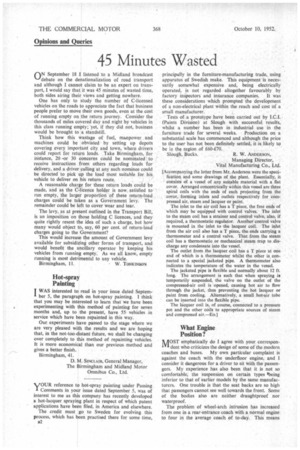Hot-spray Painting
Page 36

If you've noticed an error in this article please click here to report it so we can fix it.
WAS interested to read in your issue dated Septem
ber 5, the paragraph on hot-spray painting. I think that you may be interested to learn that we have been experimenting with this method of painting for seven months and, up to the present, have 55. vehicles .in service which have been repainted in this way.
Our experiments have passed to the stage where we are very pleased with the results and we are hoping that, in the not-too-distant future, we shall be changing over completely to this method of repainting vehicles. It is more economical than our previous method and gives a better finish.
Birmingham, 41.
D. M. SINCLAIR, General Manager,
The Birmingham and Midland Motor Omnibus Co., Ltd.
VOUR reference to hot-spray painting under Passing I Comments in your issue dated September 5, was of interest to me as this company has recently developed a hot-lacquer spraying plant in respect of which patent applications have been filed, in America and elsewhere. The credit must go to Sweden for evolving this process, which has been practised there for some time, principally in the furniture-manufacturing trade, using apparatus of Swedish make. This equipment is necessarily somewhat expensive and, being electrically operated, is not regarded altogether favourably by factory inspectors and insurance companies. It was these considerations which prompted the development of a non-electrical plant within the reach and cost of a small manufacturer.
Tests of a prototype have been carried out by I.C.I. (Paints Division) at Slough with successful results, whilst a number has been in industrial use in the furniture trade for several weeks. Production on a substantial scale has commenced and although the price to the user has not been definitely settled, it is likely to be in the region of £60-£70.
Slough, Bucks. R. W. ANDERSON,
Managing Director,
Vital Manufacturing Co., Ltd.
[Accompanying the letter from Mr. Anderson were the specification and some drawings of the plant. Essentially, it consists of a vessel of any suitable material with a flat cover. Arranged concentrically within this vessel are three spiral coils with the ends of each projecting from the cover, forming inlets and outlets respectively for compressed air, steam and lacquer or paint.
The inlet to the air coil has a T piece, the free ends of which may be equipped with control valves. The inlet to the steam coil has a strainer and control valve, also, if required, a thermostatic regulator. Another control valve is mounted in the inlet to the lacquer coil. The inlet from the air coil also has a T piece, the ends carrying a thermometer and a control valve. That from the steam coil has a thermostatic or mechanical steam trap to discharge any condensate into the vessel.
The outlet from the lacquer coil has a T piece at one end of which is a thermometer Whilst the other is connected to a special jacketed pipe. A thermometer also indicates the temperature of the water in the vessel.
The jacketed pipe is flexible and normally about 12 ft. long. The arrangement is such that when spraying is temporarily suspended, the valve on the outlet of the compressed-air coil is opened, causing hot air to flow through the jacket, thus preventing the hot lacquer or paint from cooling. Alternatively, a small hot-air tube can be inserted into the flexible pipe.
The licquer coil is, of course, connected to a pressure pot and the other coils to appropriate sources of steam and compressed air—ED.]












































































